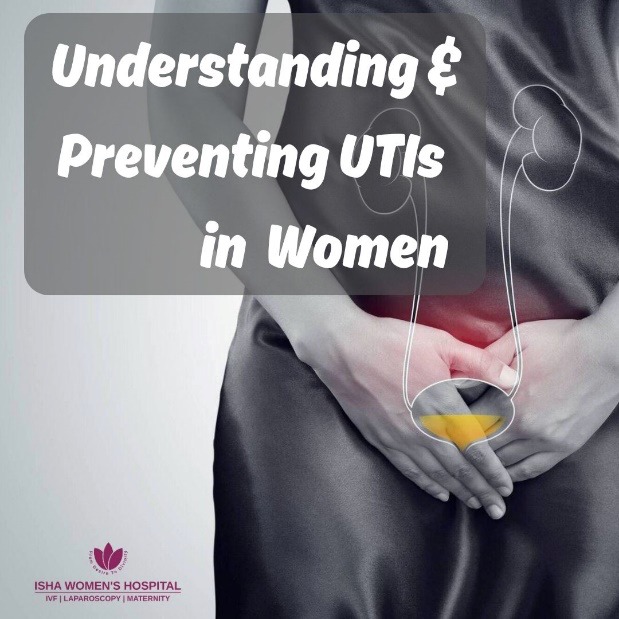Understanding and Preventing UTIs in Women

From the burning sensation during urination to frequent bathroom visits, the symptoms of a UTI can disrupt your daily life. But the good news is—UTIs are both treatable and preventable with the right awareness, hygiene habits, and timely medical care.
In this blog, let’s understand what causes UTIs, why women are more susceptible, how to recognize symptoms early, and most importantly, how to prevent infections naturally and medically. Whether you’re someone wh
What Is a UTI?
The most common type of UTI is a bladder infection, medically known as cystitis. This typically occurs when harmful bacteria enter the urethra (the tube that carries urine from the bladder out of the body) and travel upward into the bladder, where they multiply and cause inflammation and discomfort.
The main culprit behind UTIs is a bacteria called Escherichia coli (E. coli), which is naturally present in the intestines. While it’s harmless in the gut, it becomes problematic when it enters the urinary tract. Occasionally, other bacteria, fungi, or viruses may also be responsible for the infection, but E. coli remains the most frequent cause.
Why Are Women More Prone to UTIs?
- Shorter Urethra: Women have a shorter urethra (about 1.5 inches) compared to men. This means bacteria have a shorter distance to travel to reach the bladder and cause an infection, making it easier and quicker for infections to develop.
- Anatomical Proximity: The female urethra is located very close to the anus and vaginal opening. This makes it easier for bacteria from the anal or vaginal regions to come into contact with the urethra, especially if hygiene practices are poor or during sexual activity.
- Sexual Activity: Sexual intercourse can introduce bacteria into the urinary tract. Women often develop what's called honeymoon cystitis, a term for UTIs triggered by frequent or vigorous sexual activity. Friction during intercourse can push bacteria closer to the urethra.
- Hormonal Changes: During pregnancy, hormonal shifts and the growing uterus can interfere with normal urine flow, increasing the risk of infections. Similarly, postmenopausal women experience a drop-in estrogen levels, which can thin the lining of the urinary tract and reduce protective vaginal flora, making infections more likely.
- Birth Control Methods: Certain types of contraceptives, especially spermicides and diaphragms, can disrupt the natural balance of bacteria in the vaginal area and create an environment where harmful bacteria can thrive and migrate to the urinary tract.
Symptoms, Causes & Risk Factors
Common Symptoms of UTIs in Women
UTIs often cause noticeable and uncomfortable symptoms. Recognizing them early can help prevent the infection from spreading to the kidneys or causing more serious complications.
- Burning Sensation:
A sharp or stinging pain while urinating is one of the earliest signs of a urinary tract infection (UTI). - Frequent Urination:
You may feel the urge to urinate often, even if only a small amount is passed. - Cloudy or Bloody Urine:
Urine may look cloudy, pinkish (due to the presence of blood), or have a strong, unpleasant odour. - Pelvic Pain:
Women might experience discomfort, heaviness, or pressure in the bladder or pelvic area. - Low-Grade Fever:
A mild fever may be present, indicating the infection is potentially spreading to the kidneys.
Main Causes and Risk Factors for UTIs
- Poor Hygiene Practices: Improper wiping (especially back to front) after using the toilet can transfer bacteria from the anus to the urethra. Not changing sanitary pads frequently or wearing non-breathable underwear can also increase the risk.
- Sexual Activity: Sexual intercourse, particularly with new or multiple partners, can introduce bacteria into the urethra. Friction and certain positions can also contribute to the movement of bacteria into the urinary tract.
- Holding Urine for Too Long: Delaying urination gives bacteria time to multiply in the bladder, increasing the likelihood of infection. Regularly emptying the bladder helps flush out any harmful microorganisms.
- Menopause: After menopause, a drop-in estrogen levels leads to thinning of the vaginal and urinary tract lining, reducing natural protection against bacteria. This hormonal shift makes UTIs more common in postmenopausal women.
- Certain Contraceptives: Birth control methods like diaphragms and spermicides can disrupt the vaginal flora and make the urinary tract more vulnerable to infections.
- Weakened Immune System: Women with diabetes, autoimmune conditions, or those taking immunosuppressive medications are more prone to infections, including UTIs.
- Urinary Catheters: Catheter use can introduce bacteria directly into the bladder. Women with chronic catheter use or those hospitalized are at a much higher risk for UTIs.
How to Prevent UTIs Naturally and Medically
Lifestyle Habits to Prevent UTIs
Making small changes to your daily routine can go a long way in preventing infections:
- Drink Plenty of Water: Hydration is your first line of defence. Aim to drink at least 8 glasses of water a day. Water helps flush out bacteria from the urinary tract before they can cause an infection.
- Urinate Before and After Sex: Sexual activity can push bacteria into the urethra. Urinating before and after intercourse helps clear out any bacteria that may have entered the urinary tract.
- Wipe Front to Back: Always wipe from front to back after using the toilet. This prevents bacteria from the anus from being transferred to the urethra.
- Avoid Scented Feminine Products: Feminine hygiene sprays, douches, and scented tampons or pads can irritate the urethra and disrupt your body’s natural balance, making it easier for bacteria to thrive.
- Choose Breathable Clothing: Opt for cotton underwear and loose-fitting clothes. Avoid tight jeans or synthetic underwear that can trap moisture, creating an ideal environment for bacterial growth.
- Don’t Hold Urine for Too Long: Make it a habit to urinate regularly. Holding urine for extended periods gives bacteria more time to multiply in the bladder.
Dietary Tips for UTI Prevention
- Include Cranberries: Cranberries contain compounds that may prevent bacteria from sticking to the walls of the urinary tract. Try unsweetened cranberry juice or cranberry supplements if you're prone to UTIs.
- Add Probiotic-Rich Foods: Probiotics found in yogurt, kefir, sauerkraut, and kombucha help maintain a healthy balance of good bacteria, which can protect against harmful UTI-causing microbes.
- Limit Sugar Intake: High sugar levels can feed harmful bacteria and lower your body's resistance to infections. Reducing sugary foods and beverages can help prevent UTIs.
- Stay Hydrated with Water & Herbal Teas: In addition to water, herbal teas like chamomile or dandelion can promote bladder health. Avoid caffeinated or carbonated drinks that may irritate the bladder.
Medical Approaches to Prevent Recurring UTIs
- Low-Dose Antibiotics: For recurrent UTIs, doctors may prescribe a low-dose antibiotic to be taken daily or after sexual activity to prevent infections from recurring.
- Topical Estrogen Therapy: Postmenopausal women often experience UTIs due to reduced estrogen levels. Topical vaginal estrogen creams or tablets help restore the vaginal flora and improve the urinary tract's natural defenses.
- Regular Screenings: If you have frequent UTIs, regular check-ups with a gynecologist or urologist can help identify underlying issues. Early detection and monitoring help in managing and preventing future infections.
When to See a Doctor
Signs a UTI Needs Medical Attention
If you experience any of the following symptoms, it’s important to consult a doctor as soon as possible:
• Severe Pain: Intense pain in the lower abdomen, pelvic area, or lower back may indicate the infection is spreading.
• High Fever and Chills: A fever over 101°F (38.3°C), especially when combined with chills, could be a sign that the infection has reached your kidneys.
• Nausea or Vomiting: Feeling sick to your stomach or vomiting is another red flag and requires urgent care.
• Blood in the Urine: Pink, red, or cola-colored urine could indicate bleeding in the urinary tract, which may signal a more severe infection.
• Persistent Symptoms: If your symptoms last more than 2 days without improvement, or even worsen despite home care—professional treatment is essential.
How UTIs Are Diagnosed and Treated
- Urine Sample Test: A quick urine test helps detect the presence of bacteria, white blood cells, or blood, confirming the infection.
- Antibiotic Treatment: Most UTIs are effectively treated with a short course of antibiotics. Symptoms typically improve within a few days of starting medication.
If symptoms persist, a follow-up consultation and possibly additional tests may be needed to rule out other underlying causes.
Your urinary health is more than just comfort—it's a vital part of your overall well-being. The reassuring truth is that most UTIs can be prevented and treated effectively with a little awareness, good hygiene habits, and timely medical care.
Simple changes—like staying well-hydrated, wiping front to back, urinating after intercourse, and wearing breathable clothing—can go a long way in keeping infections at bay. However, if symptoms do occur, don’t ignore them. Early diagnosis and prompt treatment are key to avoiding more serious issues like kidney infections or chronic UTIs.
At Isha Women’s Hospital, we understand the discomfort and disruption UTIs can cause in your life. That’s why Dr. Chinmay Pataki, renowned gynecologist and fertility expert, leads a team committed to compassionate, accurate, and personalized care—helping women feel confident and healthy at every stage.
If you're experiencing symptoms or want to prevent future infections, reach out to Isha Women’s Hospital today. Your health deserves expert attention—and we’re here to support you every step of the way.
Frequently Asked Questions (FAQs)
Ans - Mild UTIs might improve with hydration, but most need antibiotics to avoid complications.
2. Why do I keep getting UTIs?
Ans - Could be due to anatomical factors, hormonal changes, or lifestyle habits—talk to a doctor.
3. Are cranberries really helpful for UTIs?
Ans - Cranberries may help prevent UTIs but don't cure active infections.
4. How quickly should I see a doctor if I suspect a UTI?
Ans - Immediately if symptoms are severe or last beyond 48 hours.
5. Does drinking a lot of water help prevent UTIs?
Ans - Yes—flushing bacteria out reduces your risk of infection.
